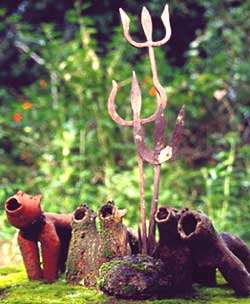 |
| Edged out: Terracotta icons of the hounds
of the hunt in a Kodagu grove |
As the ka law kyntanks in the
undulating hills of Meghalaya experience minor ripples of change, the sacred groves or devarakadus
in the Western Ghats of Karnataka are caught in a whirlpool of a transforming world.
In this area, where patches of forest
stand out among coffee plantations and paddy-fields, are found ancient shrines comprising
solitary stones, terracotta icons and miniature tridents (trishul) placed under
canarium or garcinia trees, which are endemic to the region. These groves, with their own
rites and ideologies, are facing a rapid cultural and economic onslaught that seeks to
overturn the traditional way of life.
Each year, the Soliga tribals of the B R
Hills in Chamrajnagar district celebrate the roti habba festival dedicated to
Shiva. On that day, members of the community dress up in their finest and trek a steep
rocky path braving elephants, gaurs and snakes to reach the Chikka Sampige sacred grove,
which is 15 km from the Karnataka–Tamil Nadu highway. Once there, they prepare ragi
rotis and pumpkin curry, which they offer to the deity. After that, they dance and
frolic till the early hours of the morning. Once the ceremony is over, the grove is
forgotten till the next year.
The unique festival of roti
habba has survived for decades. But sacred groves are fast losing their relevance in
the societal fabric of several communities, such as in Kodagu district. They are regularly
encroached upon and converted into plantations, agricultural fields or homesteads. Old
ways are giving in to the new. Mismanagement by political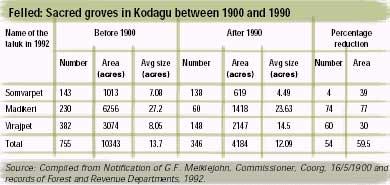 regimes have also had devastating results. regimes have also had devastating results.
Whose groves are these anyway?
The first ever survey of sacred groves in Kodagu was conducted in
1873, when 873 groves covering 4,398.79 ha were listed. Under the then The Indian Forests
Act, 1875, these were declared as "protected forests". An 1898 report compiled
in the office of the Commissioner of Coorg (Kodagu) states that the sacred groves or devarakadu
then comprised 6,275.081 ha out of 45,0118.3 ha of total forest land.
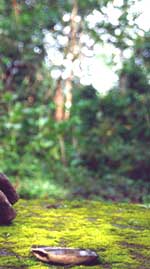 In 1905, the ownership of the Kodagu devarakadus
changed hands and went to the Revenue Department. This transfer of ownership came at a
heavy price. According to anthropologist M A Kalam, between 1905 and 1985, the extent of
sacred groves in Kodagu had shrunk to just 2406.768 ha. In other words, a whopping 42 per
cent of sacred grove area was lost in just 80 years. In 1905, the ownership of the Kodagu devarakadus
changed hands and went to the Revenue Department. This transfer of ownership came at a
heavy price. According to anthropologist M A Kalam, between 1905 and 1985, the extent of
sacred groves in Kodagu had shrunk to just 2406.768 ha. In other words, a whopping 42 per
cent of sacred grove area was lost in just 80 years.
Although the government returned the
groves to the Forest Department under the Indian Forest Act, 1927, the battle between the
Revenue and the Forest departments continued, as each claimed the devarakadus for
themselves. In 1956, the province of Kodagu was merged with the state of Karnataka.
Finally in 1985, the Revenue Department formally handed over the ownership of devarakadus
to the Forest Department and the devarakadus were declared as reserve forests under
sections 4, 17 and 26 of the Karnataka Forest Act, 1963. But most of the damage had
already taken place by then (see table: Felled).
In 1987, the Karnataka state
government ordered that the Forest Department allow the felling of timber in devarakadu
areas only if the wood goes towards renovating the temple to which the grove is attached.
This order remains in force.
Change of address: Temples like this one in the
Hebbale sacred grove can signify more than just a new residence for the gods, they are the
result of changing social dynamics |
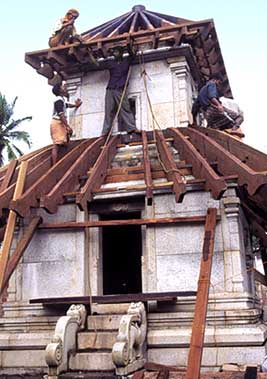 |
A survey conducted by the Department of
Ecology, Environment and Forests, Government of Karnataka, in the early 1990s found that
45 per cent of the groves had been reduced to less than one acre. A more acceptable figure
would be 2,550 ha or 2 per cent of the total forest cover of the state, as stated by
Claude Garcia.
Veneration of the gods and spirits has
certainly not protected the forests they reside in. According to Jeevan Chinnappa, Kodagu
correspondent for the national daily, The Hindu, "Influential people
encroached the sacred grove lands 15-20 years ago and converted them into coffee
plantations. Today these lands have been regularised." But this is not a recent
phenomenon. Before 1956, when Kodagu became part of Karnataka state, sacred groves were
often declared paisari land, de-notified for plantation or housing.
Old faith, new gods
Just as the forests of India have never remained pristine or isolated, the societies
living within them have to engage with new dynamics and economies, very often to their
detriment. Besides their spiritual significance, sacred groves also act as tools to
ascertain local identity. Devarakadus are an integral part of Kodava culture. It is
what sets them apart. It is this cultural identity that may be at stake.
The Kodavas are the dominant community in
Kodagu. The head of a Kodava family is appointed as deva takka or head of a local
temple. "Legend has it that the goddess identified one family in the village to take
care of the well being of the tribals," says C G Kushalappa, professor, Forestry
College, Ponnampet, Kodagu. However, the role of the takkas is confined to
organising the annual festival. "Management of the forest has never been given any
importance. They only provide space for our gods and there has been no ecological reason
for preserving small patches of forests," says Padeyanda Shambu, takka of
Kaykad devarakadu, Virajpet, Kodagu.
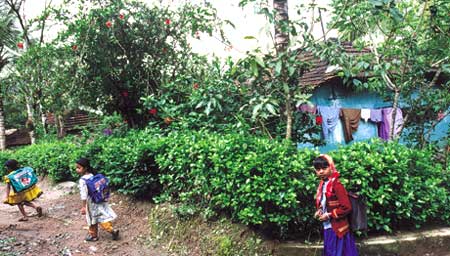 |
Change of guard in
the Manilayappa grove:
Numerous devarakadus were converted into plantations or housing colonies by the paisari
system. Others have been simply encroached upon |
Besides organising festivals, the takkas
have to provide for the well-being of the community priest. Kala Kuruba, the priest at
Hebbale devarakadu in Devapura says " The deva takka of the Hebbale deverakadu
has given me two acres of land to cultivate and make a living. Besides this, I get Rs
1,000 from the takka every year for performing the rituals during the
festival."
To some extent, the sacred groves
festivals in Kodagu are witnessing a process of culturalisation by which upper caste
communities have adopted traditional "lower caste" practices. Kala Kuruba, the
old priest of the Hebbale sacred grove, says, "During the kundi habba
festival, the Kuruba tribals clean our temple premises. Then we offer fowl and toddy (a
local alcoholic liquor) to the god Ayappa and abuse him. This way, we rid our minds of all
evil thoughts." However, there are greater instances that show the widespread effects
of a new transformation. While earlier, human sacrifice was a common feature during the
sacred grove festivals, today, these practices have been replaced with animal sacrifice.
In some sacred groves, such as the Suggi devarakadu in Somvarpet, even animal
sacrifice is strictly forbidden. Kalam calls this a conscious attempt to
"vegetarianise the deities in order to Sanskritise them" and bring them to the
fold of Hinduism. In the Suggi grove, even a person who has just eaten meat is not allowed
inside. It is said that anybody defying this rule is stung by bees.
| Upwardly mobile: A priest in the Kaykad devarakadu in
Virajpet |
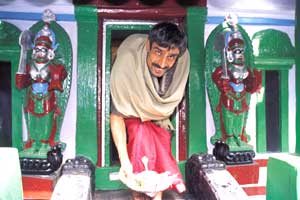 |
The influence of Hinduism has led to the
construction of large, imposing temples with Brahmin priests and Hindu gods and goddesses
within the sacred groves. By definition, sacred groves have been reduced to temple groves.
Importance is given to the temple itself. From temple groves to a temple is just a step
away.
Kushallappa says, "We have to
accommodate such changes because we have evolved from nature worship to a structured
worship. However, it cannot be ignored that in modern times, conservation for its own sake
is gaining importance and the groves provide the space to fulfill this need".
One such instance is the Bhadrakali
sacred grove in Hudikere. It has got a facelift. A newly painted blue temple has replaced
an old run down shrine. This is a sign that the community has finally taken the
responsibility of managing the shrine and the Australian Silver Oak grove contributed by
the Forest Department under its renovation programme.
In a bid to revive the tradition of
sacred groves in Kodagu, a Devarakadu Thakka Mukhyastra Vedike (Sacred Groves Federation)
was formed in 2002, chaired by the conservator of forests. The vedike programme draws
heavily from traditional management practices, along with existing state forest and Joint
Forest Management (JFM) policies. However, it is not authenticated by the state
government.
| Uttara Kannada –
commercially sacred  The tradition of sacred groves is not limited to
Kodagu. In Uttar Kannada, sacred groves or kans proliferate though in varying
stages of degradation. In Uttara Kannada, people lost their rights over the kan
forests as early as in 1800, when the British took over the area. The tradition of sacred groves is not limited to
Kodagu. In Uttar Kannada, sacred groves or kans proliferate though in varying
stages of degradation. In Uttara Kannada, people lost their rights over the kan
forests as early as in 1800, when the British took over the area.
In the neighbouring Shimoga district, they were taken by the government and leased out
to the landlords. They were recognised as a separate management system until the 1960s. In
2001,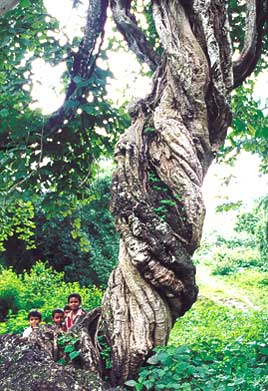 the kans of
Shimoga were declared as minor forests or state forests or revenue forests, whereas in
Uttara Kannada, they were declared as protected forests or revenue forests depending on
the lands they were on. the kans of
Shimoga were declared as minor forests or state forests or revenue forests, whereas in
Uttara Kannada, they were declared as protected forests or revenue forests depending on
the lands they were on.
Thus, in comparison to Kodagu, where the Forest Department has recognised the existence
of sacred groves, the kans of Shimoga, Chikmaglur and Uttara Kannada have not been
able to secure such a status. Yogesh Gokhale, research assistant, Centre for Ecological
Sciences, Indian Institute of Sciences, says, "The kans have been referred to
as the historical sacred forests as people continue to have faith in the deity, but this
sacredness could not be protected from larger commercial interests".
The kans contribute to 5.85 per cent of the total land use in Uttara Kannada. In
some cases they are found on the soppina betta (leaf manure forests) lands, which
are also owned by the forest department but managed by individual families. They are also
found associated to the hakkal bena (agricultural fields).
The sanctions on extraction from the kans are very flexible. The people in
Shimoga and Uttara Kannada can tap toddy, honey, gum, cultivate pepper and collect leaves
for manure from the kans. As utilitarian lands they cater to the needs of the
villagers. However, the kan holder has no permission to plant coffee. Between 1966
and 1985, a number of kans were converted into acacia auriculiformis plantations by the
forest department. |
|